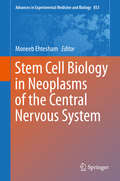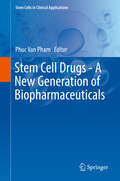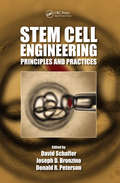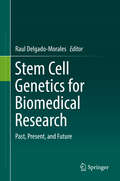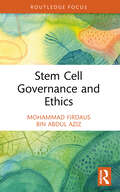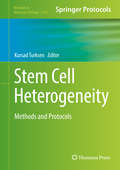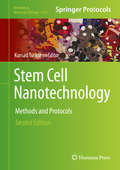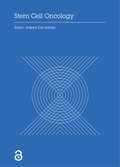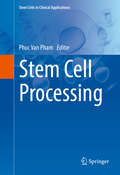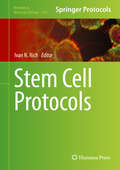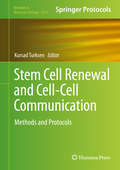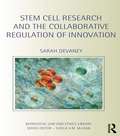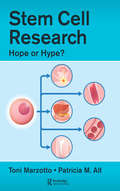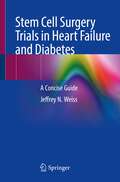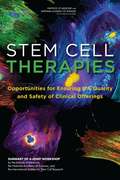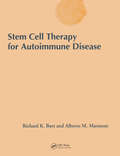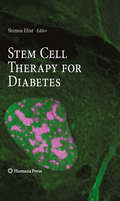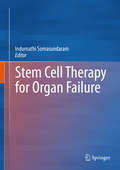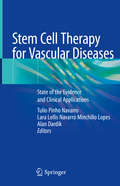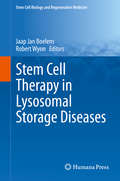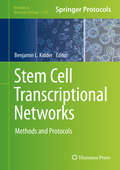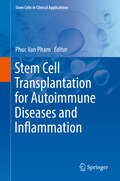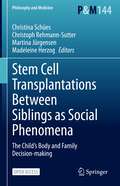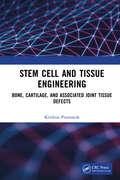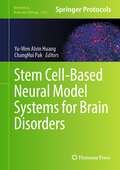- Table View
- List View
Stem Cell Biology in Neoplasms of the Central Nervous System
by Moneeb EhteshamThis volume presents the most current reviews on how cancer stem cells (CSCs) hypothesis dictates that the continued proliferation of a tumor is dependent on a sub-population of self-renewing and asymmetrically dividing neoplastic stem cells that supply a largely differentiated tumor. This volume provides a comprehensive overview of the characteristics of CSCs, their role in central nervous system (CNS) tumors, and the recent CSC-specific treatment modalities being used. The emerging focus on CSCs in brain tumors represents a paradigm shift in our understanding of the pathogenesis of these neoplasms. Importantly, the realization that a distinct sub-population of cells contributes disproportionately to the growth and sustenance of central nervous system tumors has important implications for the treatment of such tumors. To treat CNS tumors, there is now a growing need to treat CSCs to achieve adequate tumor control.
Stem Cell Drugs - A New Generation of Biopharmaceuticals
by Phuc Van PhamThis invaluable resource discusses the current revolution in stem cell-based drugs and their potential use in clinical applications. Each chapter is contributed by a pre-eminent scientist in the field. An introductory section presents current stem cell drugs and stem cell-based products and a discussion of production, quality control, mechanisms, and efficacy. Following sections include discussions on stem cell-derived microvesicles based products, and derived exosomes based products. Stem Cell Drugs - A New Generation of Biopharmaceuticals and the other books in the Stem Cells in Clinical Applications series are invaluable to scientists, researchers, advanced students and clinicians working in stem cells, regenerative medicine or tissue engineering. This groundbreaking volume is also essential reading for those researching or studying drug development or pharmaceutical science.
Stem Cell Engineering: Principles and Practices
by Joseph D. Bronzino Donald R. Peterson David SchafferWhile the potential of stem cells is recognized, their proliferation and differentiation must be more precisely controlled to maximize the production of therapeutically relevant cells and for cell replacement therapies to minimize contamination with residual cells that can give rise to side effects. With contributions from pioneers and experts, this book provides a broad overview of the challenges of stem cell engineering. It discusses advances made during the last decade that have led to increasingly defined culture systems for growing human ES cells, starting from co-culture with feeder cells in the presence of serum to growth on synthetic substrates in defined medium. The book highlights recent advances in the understanding of the cellular and molecular composition of the hematopoietic stem cell niche, as well as approaches to build upon this basic information to direct stem cell differentiation into blood cell lineages.
Stem Cell Genetics for Biomedical Research: Past, Present, and Future
by Raul Delgado-MoralesThis book looks at where stem cell technology is presently and how it is instrumental in advancing the field of disease modeling and cell transplantation. By focusing on major human disorders such as Alzheimer’s disease, cancer, and heart disorders, the book summarizes the major findings in the field of human stem cells and dissect the current limitations on our understanding of stem cells biology. The chapters focus on the genetics, genomics, epigenetics and physiology of stem cells models, together with technological advances on molecular biology such as CRISPR/Cas9 or epigenetic editing, that will be instrumental in the future of human disease modeling and treatment. In base of the limitations of current disease models and in front of the unmet necessity of finding therapeutical interventions for human disorders, the availability of stem cell technology has opened new doors for several fields. The unlimited self-renewal capacity and more extensive differentiation potential of stem cells offers a theoretically inexhaustible and replenishable source of any cell subtype. Since Professor Shinya Yamanaka described it, 10 years ago in his seminal paper, that somatic cells could be reprogrammed to inducible stem cells (iPSC) just by expressing four transcription factors, the field of has exploded, especially its applications in biomedical research.
Stem Cell Governance and Ethics (Routledge Studies in Asian Law)
by Mohammad Firdaus AzizThis book explores the ethical and governance concerns of stem cell technology, taking a comparative approach between countries of differing socio-economic status.The book provides a typology of different stem cell types and discusses key ethical issues surrounding the use of human stem cells in research. Topics covered include the moral status of human embryos, various religious perspectives, and the challenges posed by unproven stem cell interventions. The book also examines the existing governance frameworks in the United Kingdom, Singapore, and Malaysia, identifying the laws, guidelines, and advisory bodies established to address the identified ethical issues. Applicable lessons on establishing robust regulatory frameworks, fostering public trust, and ensuring responsible research practices are outlined.By providing a comparative analysis of the interplay between ethics, governance, and the socio-economic contexts of these three commonwealth countries, this book will interest health law, research ethics, and bioethics scholars.
Stem Cell Heterogeneity
by Kursad TurksenGiven the variety of studies and data that have suggested the existence of heterogeneous populations or subpopulations of stem cells, this detailed volume examines different aspects of stem cell heterogeneity. This goes against the long-held tenet that stem cells, defined by their capacity for self-renewal and lineage development, comprised a homogenous population, thus providing the reader with a new avenue of exploration into the complex world of stem cell study. Written for the highly successful Methods in Molecular Biology series, chapters include introductions to their respective topics, lists of the necessary materials and reagents, step-by-step, readily reproducible laboratory protocols, and tips on troubleshooting and avoiding known pitfalls. Authoritative and practical, Stem Cell Heterogeneity: Methods and Protocols serves as an ideal guide for investigators exploring this important area of research.
Stem Cell Nanotechnology: Methods And Protocols (Methods In Molecular Biology Ser. #1058)
by Kursad TurksenThis fully updated edition brings together a new set of protocols to arm stem cell biologists with tools and approaches to continue the quest to uncover the intricacies and regulatory circuits underlying stem cell biology. The collection explores the tremendous progress in our understanding of the potential of stem cells and the regulatory mechanisms controlling their fate, particularly through the parallel advances in nanotechnologies and their applications in biology. Written for the highly successful Methods in Molecular Biology series, chapters include introductions to their respective topics, lists of the necessary materials and reagents, step-by-step, readily reproducible laboratory protocols, and tips on troubleshooting and avoiding known pitfalls. Authoritative and practical, Stem Cell Nanotechnology: Methods and Protocols, Second Edition serves a valuable tool for experts and novices alike in the vital field of stem cell research.
Stem Cell Oncology: Proceedings of the International Stem Cell and Oncology Conference (ISCOC, 2017), December 1-2, 2017, Medan, Indonesia
by Adeya AdellaStem cell research is one of the fascinating areas of contemporary biology, but, as with many expanding fields of scientific inquiry, research on stem cells raises scientific questions as rapidly as it generates discoveries. Research on stem cell treatment continues to advance knowledge about how an organism develops from a single cell and how healthy cells replace damaged cells in adult organisms. The most important potential application of human stem cells is the generation of cells and tissues that could be used for cell-based therapies, especially oncology. The Faculty of Medicine, Universitas Sumatera Utara, collaborated with the center of excellence and innovation (Pusat Unggulan Inovasi /PUI). The Stem Cell center of the Universitas Sumatera Utara (USU) organized an International Conference. The International Stem Cell and Oncology Conference (ISCOC) 2017 was a comprehensive academic conference in the field of stem cell and oncology research and also tropical medicine and related scientific topics. We expect Stem Cell Oncology will benefit academics and practitioners in the field of health sciences in Indonesia. This is an Open Access ebook, and can be found on www.taylorfrancis.com.
Stem Cell Processing
by Phuc PhamThis invaluable resource delineates procedures for development and use of stem cells in the laboratory and explores the potential for clinical applications. The text discusses mesenchymal stem cell isolation, isolation of adipose derived stem cells, new trends of induced pluripotent stem cells in disease treatment, cord blood banking, future directions of the discussed therapies and much more. The chapters are contributed by preeminent scientists in the field and present a comprehensive picture of stem cell processes, from development in the laboratory to effects and side-effects of clinical application. Stem Cell Processing and the other books in the Stem Cells in Clinical Applications series, edited by Dr. Phuc Van Pham, is essential reading for scientists, researchers, advanced students and clinicians working in stem cells, regenerative medicine or tissue engineering.
Stem Cell Protocols
by Ivan N. RichThis volume presents up-to-date methods that allow primary stem cells from a variety of sources to be isolated, cultured in vitro, detected and measured for specific applications. These applications range from those in basic, stem cell and veterinary research to toxicology, cellular therapy and regenerative medicine. There is a slight bias towards the blood-forming system as more is known about the blood-forming or hematopoietic system than any other primary stem cell system. These unique properties and characteristics are discussed and examined, mostly at the cellular level and in detail in this book. Written in the successful Methods in Molecular Biology series format, chapters include introductions to their respective topics, lists of the necessary materials and reagents, step-by-step, readily reproducible protocols, and notes on troubleshooting and avoiding known pitfalls. Authoritative and accessible, Stem Cell Protocols provides novices with the fundamentals necessary to develop new technologies necessary for basic and clinical research in the future, and will aid professionals in finding new methodologies to provide a wider viewpoint and an even greater scope for their own research.
Stem Cell Renewal and Cell-Cell Communication
by Kursad TurksenThis volume examines cell-cell interactions and stem cell renewal, two topics that are now inexorably linked as science strives to understand the stem cell niche and its function. Gathering a number of representative protocols, this detailed collection promises to provide readers with approaches for studying these complimentary aspects of stem cells. Written for the highly successful Methods in Molecular Biology series, chapters include brief introductions to their respective topics, lists of the necessary materials and reagents, step-by-step, readily reproducible laboratory protocols and tips on troubleshooting and avoiding known pitfalls. Practical and reliable, Stem Cell Renewal and Cell-Cell Communication: Methods and Protocols will aid researchers in using these methods to advance their own studies.
Stem Cell Research and the Collaborative Regulation of Innovation (Biomedical Law and Ethics Library)
by Sarah DevaneyHopes are high that stem cell (SC) research will lead to treatments and cures for some of the most serious diseases affecting humankind today. SC science has been used in a treatment setting in the replacement of patients’ windpipes and in restoring sight to patients who were blind in one eye and in future it is hoped that when the body is injured it will be able to be stimulated to produce those types of SCs necessary to repair the particular damage caused. In the meantime, research into specific treatments for a wide range of serious conditions is being undertaken including Alzheimer’s disease, cancer, and diabetes. The book considers the regulatory governance of stem cell research, setting out a readily understandable account of the science and the challenges it poses for regulators as the research is increasingly being clinically applied. It provides a critical account of those elements of a regulatory system which will be required for any jurisdiction aiming to facilitate innovative and productive SC research while maintaining appropriate ethical and legal controls. The book addresses the specific failings in the current regulatory approach to SC research in the UK and goes on to look at the regulatory approaches in the US. The book systematically analyses the roles and responsibilities of the three key participants who collaborate in this process: regulators, scientists and tissue providers, arguing that a regulatory system which fails to recognise and facilitate the vital role which each of these three groups plays runs the risk of impairing the chances of the hopes for SC research being realised. The book places a particular emphasis on ensuring that those who contribute their bodily tissues to this endeavour are treated fairly, involving a recognition that their tissues are their property.
Stem Cell Research: Hope or Hype?
by Toni Marzotto Patricia M. AltStem Cell Research takes a multi-disciplinary approach to the topic of human embryonic stem cell research, starting with the breakthrough discovery up through the present day controversy. The book invites the reader to join the conversation by providing a well balanced approach to many of the issues surrounding the development of this controversial scientific field. It includes the thoughts and experiences of scientists, journalists and ethicists as it tried to approach the topic through a variety of different academic disciplines. The book will help the non-scientist understand the biology, research regulations and funding; and simultaneously it will help the scientist better comprehend the full spectrum of ethical, religious, and policy debates.
Stem Cell Surgery Trials in Heart Failure and Diabetes: A Concise Guide
by Jeffrey N. WeissThis book examines the application of stem cell surgery for diabetes and heart failure. Organized into two sections, the first identifies and summarizes the current worldwide stem cell trials for heart failure. Subsequent chapters in part two analyze the current worldwide stem cell trials in patients with Diabetes Mellitus. Both sections utilize studies that include non-expanded stem cells; each study is grouped by stem cell type and geographic location. Stem Cell Surgery Trials in Diabetes and Heart Failure is a comprehensive, convenient reference for cardiologists, endocrinologists, internists, and family physicians.
Stem Cell Therapies
by Adam C. BergerStem cells offer tremendous promise for advancing health and medicine. Whether being used to replace damaged cells and organs or else by supporting the body's intrinsic repair mechanisms, stem cells hold the potential to treat such debilitating conditions as Parkinson's disease, diabetes, and spinal cord injury. Clinical trials of stem cell treatments are under way in countries around the world, but the evidence base to support the medical use of stem cells remains limited. Despite this paucity of clinical evidence, consumer demand for treatments using stem cells has risen, driven in part by a lack of available treatment options for debilitating diseases as well as direct-to-consumer advertising and public portrayals of stem cell-based treatments. Clinics that offer stem cell therapies for a wide range of diseases and conditions have been established throughout the world, both in newly industrialized countries such as China, India, and Mexico and in developed countries such as the United States and various European nations. Though these therapies are often promoted as being established and effective, they generally have not received stringent regulatory oversight and have not been tested with rigorous trials designed to determine their safety and likely benefits. In the absence of substantiated claims, the potential for harm to patients - as well as to the field of stem cell research in general - may outweigh the potential benefits. To explore these issues, the Institute of Medicine, the National Academy of Sciences, and the International Society for Stem Cell Research held a workshop in November 2013. "Stem Cell Therapies" summarizes the workshop. Researchers, clinicians, patients, policy makers, and others from North America, Europe, and Asia met to examine the global pattern of treatments and products being offered, the range of patient experiences, and options to maximize the well-being of patients, either by protecting them from treatments that are dangerous or ineffective or by steering them toward treatments that are effective. This report discusses the current environment in which patients are receiving unregulated stem cell offerings, focusing on the treatments being offered and their risks and benefits. The report considers the evidence base for clinical application of stem cell technologies and ways to assure the quality of stem cell offerings.
Stem Cell Therapy for Autoimmune Disease
by Richard K. BurtStem cell transplantation may be complicated by treatment-related mortality and like the immune system that it regenerates has equal potential to either create and preserve or destroy. The dual nature that defines stem cells is differentiation that ultimately leads to death and self-renewal, which leads to immortality. What types of stem cells are there? How are they collected? What are their attributes and characteristics? This textbook devotes many chapters to familiarize the reader with the basic science, clinical aspects, and new questions being raised in the field of stem cell biology. Blood stem cells for tolerance and tissue regeneration are a rapidly developing research and clinical field that is being applied to autoimmune diseases. In clinical trials, autologous hematopoietic (blood) stem cells are being used to reduce the cytopenic interval following intense immune suppressive transplant regimens. While as yet not delineated, some possible mechanisms and pathways leading to tolerance after hematopoietic stem cell transplantation are suggested in these chapters. Tissue regeneration from blood stem cells is also suggested by animal experiments on stem cell plasticity or metamoirosis (i.e., change in fate) as described within this textbook. Ongoing early clinical trials on tissue regeneration from blood stem cells are described in the chapter on stem cell therapy for cardiac and peripheral vascular disease. Whether autologous hematopoietic stem cells, through the process of mobilization and reinfusion, may be manipulated to contribute to tissue repair in autoimmune diseases is a future area for translational research.
Stem Cell Therapy for Diabetes
by Shimon EfratStem Cell Therapy for Diabetes, one of the latest installments of the Stem Cell Biology and Regenerative Medicine series, reviews the three main approaches for generation of sufficient numbers of insulin-producing cells for restoration of an adequate beta-cell mass: beta-cell expansion, stem-cell differentiation, and nuclear reprogramming. Adeptly collecting the research of the leading scientists in the field, Stem Cell Therapy for Diabetes compares the merits of employing autologous versus banked allogeneic cell sources for generation of surrogate beta cells, and addresses tissue engineering and ways for cell protection from recurring autoimmunity and graft rejection. Stem Cell Therapy for Diabetes provides essential reading for those especially interested in tracking the progress in applying of one of the most exciting new developments in bio-medicine towards a cure for diabetes.
Stem Cell Therapy for Organ Failure
by Indumathi SomasundaramThe book "STEM CELL THERAPY FOR ORGAN FAILURES" edited by Dr. S. Indumathi demonstrates the In Vitro and In vivo therapeutic strategies and applications of pre- and post-natal stem cells for treating the failures of various organ systems of our body in a wide perspective. It explores the past, present and the futuristic approach of the exciting field of stem cells and its intriguing properties involved in tissue repair and regeneration. The prime focus of this volume is to unravel the basic, advanced, therapeutic and translational approaches put-forth so far in the field of stem cells and regenerative medicine at research, pre-clinical and clinical levels. Stem cells has ushered in widespread interest and exciting possibilities for cell based therapies, albeit failures do prevail and small uncontrolled phase I/II studies are only signals generating, rather than definite proof of concept thereby limiting its applicability in curative therapeutics. Despite certain initiatives and meticulous untiring efforts, bringing this basic bench side research into advanced transitional bedside remained a challenge. Thus, this book embarked upon the expanding researches in these areas that seem decisive in improvising regenerative medical therapeutics, thereby leading to further path-breaking studies that cure all health challenges facing mankind. Overall, this book reveals the imperativeness of various stem cell sources and its utility in curative therapeutics.
Stem Cell Therapy for Vascular Diseases: State of the Evidence and Clinical Applications
by Alan Dardik Tulio Pinho Navarro Lara Lellis Navarro Minchillo LopesVascular diseases are the leading cause of death worldwide. Distinguished clinical and surgical approaches have attempted to overcome its morbidity and mortality; still 17.9 million people die every year due to vascular affections. Stem cell therapy has emerged as a promising therapeutic strategy. Stem cells synthesize and secrete cytokines that promote cell recruitment, immunomodulation, extracellular matrix remodeling, angiogenesis, and neuroregeneration, all of which promote regeneration. Besides that, stem cells are also capable of differentiating in various cell types, being employed in tissue engineering. Preclinical and clinical investigations have reported efficacy of stem cell therapy for various vascular diseases. Even though results are encouraging, the studies demonstrate variation in stem cell type and origin, route and protocol for administration, and concomitant use of other treatment strategies, impairing easy interpretation of results and clinical application. The purpose of this book is to compile and comprise the current state of the evidence regarding stem cell therapy for each vascular disease, elucidating possible clinical applications. More than an objective guide for readers on the use of this novel treatment strategy, this publication will advocate for stem cell therapy use and development and will be of significant interest to physicians in a wide range of disciplines as well as researchers.
Stem Cell Therapy in Lysosomal Storage Diseases
by Jaap Jan Boelens Robert WynnStem Cell therapy for lysosomal diseases (LSDs) is developing rapidly. This volume discusses the history, current practice and future perspectives of stem cells in inborn errors of metabolism (IEM) and provides an international perspective on progress, limitations, and future directions (e. g. gene therapy, iPS, ES) in the field. Beginning with an overview of these diseases, the book covers the breadth of this topic from treatment options, bone marrow transplantation, and alternative treatment options, through long-term outcomes and future perspectives.
Stem Cell Transcriptional Networks
by Benjamin L. KidderStem Cell Transcriptional Networks: Methods and Protocols collects techniques used to increase our understanding of the underlying transcriptional programs of stem cells that promote self-renewal and differentiation. The volume opens with a section on next-generation sequencing library preparation and data analysis. Continuing with a collection of protocols on visual analysis and interpretation of large-scale interaction networks, this detailed compilation features transcriptional networks in embryonic and adult stem cells, embryo culture and derivation of stem cells, as well as transcriptional programs that promote self-renewal, reprogramming, and transdifferentiation. Written for the highly successful Methods in Molecular Biology series, chapters include introductions to their respective topics, lists of the necessary materials, step-by-step, readily reproducible protocols and tips on troubleshooting and avoiding known pitfalls. Authoritative and practical, Stem Cell Transcriptional Networks: Methods and Protocols aims to provide a key resource for biologists seeking to interrogate these vital networks.
Stem Cell Transplantation for Autoimmune Diseases and Inflammation (Stem Cells in Clinical Applications)
by Phuc Van PhamThis book introduces many new technologies and clinical applications of hematopoietic stem cells and mesenchymal stem cell transplantation for the treatment of autoimmune diseases and inflammatory diseases. Presented in two parts, Part 1 focuses on stem cell therapies for autoimmune disease treatment; Part 2 focuses on stem cell therapies and their application in the treatment of common inflammatory diseases, including chronic knee osteoarthritis, chronic obstructive pulmonary disease, liver cirrhosis, Crohn's Disease, Multiple Sclerosis, and more. This book is an essential source for all advanced students and researchers involved with these diseases, stem cells, or both. Stem Cell Transplantation for Autoimmune Diseases and Inflammation and the other books in the Stem Cells in Clinical Applications series are invaluable to scientists, researchers, advanced students and clinicians working in stem cells, regenerative medicine, or tissue engineering as well as cancer or genetics research.
Stem Cell Transplantations Between Siblings as Social Phenomena: The Child’s Body and Family Decision-making (Philosophy and Medicine #144)
by Christoph Rehmann-Sutter Christina Schües Martina Jürgensen Madeleine HerzogThis open access book offers insights in short- and long-term experiences from families with bone marrow transplantations between minor siblings. It is based on the first extended qualitative study with 17 families about experiences with recent transplants and experiences with transplants up to 20 years in the past. It covers reflections of donors, recipients and other family members, as well as family interactions. Transplantation of bone marrow from one sibling to another who is ill with a blood cancer (such as Leukemia) is a life-saving therapy. Young children however are not in a position to give consent themselves. How should they be adequately included, depending to their age? Which ethical questions are raised for the parents both at the time of treatment and afterwards, and for the medical professionals in clinical and regulatory contexts? For an in-depth discussion of the findings the books brings together a group of leading scholars from the fields of bioethics, family sociology and philosophy of medicine.
Stem Cell and Tissue Engineering: Bone, Cartilage, and Associated Joint Tissue Defects
by Krishna PramanikThis book covers conventional clinical treatment methods for handling bone, cartilage, and related disorders along with their limitations and highlights the current state of the art of tissue engineering as an alternative for regenerating such defective tissue. Potential biomimetic scaffolding materials and their development, desired properties, modifications, and optimizations are described. The design and advancement in fabrication, characterization, properties, and biological functions of scaffolds, their integration with stem cells, and various bioreactor systems for tissue regeneration are presented. It further reviews in vitro and in vivo (pre-clinical) assessments of tissue constructs, involved translational challenges, and strategies in various stages of neo-tissue production.Features: Discusses the key aspects of generating engineered bone, cartilage, and associated tissues through tissue engineering approach Describes multiple engineering principles, and processes involved in the various stages of developing biomaterials and scaffolds Covers integration of stem cells with scaffolds, including assessment of tissue grafts, and translational strategy Explores key factors influencing tissue graft generation in bioreactors and challenges involved in various stages Includes several exercises including review questions and numerical problems for better understanding of the subject This book is aimed at researchers, students, and professionals in biomedical engineering, tissue engineering, stem cells, biomaterials, and orthopaedics.
Stem Cell-Based Neural Model Systems for Brain Disorders (Methods in Molecular Biology #2683)
by Yu-Wen Alvin Huang ChangHui PakThis detailed volume presents validated and well-adapted procedures involving humanized and/or stem cell-based neural model systems that have proven helpful in better understanding the essential brain functions involved in the pathogenesis of brain disorders. The book explores the generation of multiple neural cell types in 2D and 3D as well as cutting-edge techniques to assay neural function. Written for the highly successful Methods in Molecular Biology series, chapters include introductions to their respective topics, lists of the necessary materials and reagents, step-by-step and readily reproducible laboratory protocols, and tips on troubleshooting and avoiding known pitfalls. Authoritative and practical, Stem Cell-Based Neural Model Systems for Brain Disorders serves as an essential resource for researchers and students in neuroscience, stem cell biology, and related fields.
